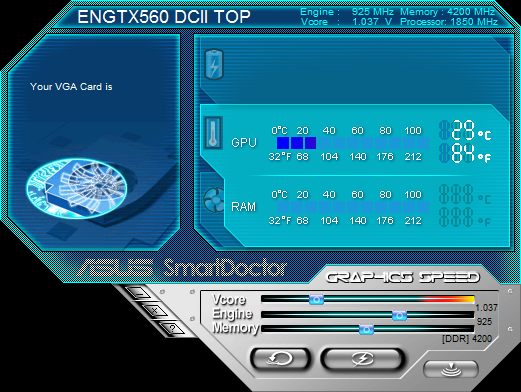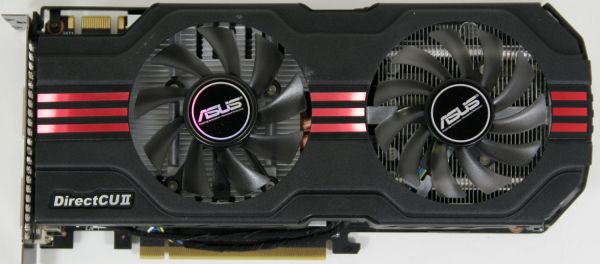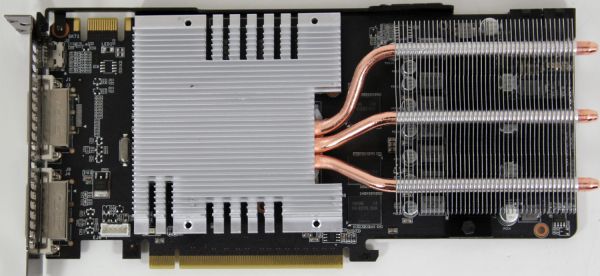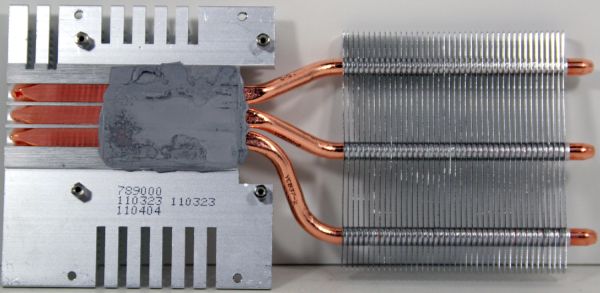NVIDIA's GeForce GTX 560: The Top To Bottom Factory Overclock
by Ryan Smith on May 17, 2011 9:00 AM ESTMeet ASUS’s GTX 560 DirectCU II Top
As we mentioned previously, the card we’re sampling today is ASUS’s GTX 560 DirectCU II Top, the faster of ASUS’s two GTX 560s, and the 2nd fastest card on NVIDIA’s launch list. It’s clocked at 925MHz for the core and 4200MHz (data rate) for the memory, giving it a sizable 115MHz (14%) core clock and 196MHz (5%) memory clock advantage over the GTX 560’s reference clocks. As we’ll see when we get to benchmarking, this is fast enough to start challenging reference clocked GTX 560 Tis.
We’ve reviewed a number of ASUS DirectCU cards in the past, but this is the first card we’ve reviewed from them that uses the DirectCU II cooler. What’s the difference? The DirectCU (I) was an open air cooler with single fan mounted at the center of the card; the DirectCU II uses two 80mm fans. In practice it’s similar to some previous coolers we’ve seen such as MSI’s Twin Frozr, however ASUS has managed to throw in their own unique adjustments.
Notably, the DirectCU II uses a different fan configuration than what we normally see with these dual-fan cards. Normally these cards are symmetrical – the left and right fans are the same. In the case of the DirectCU II ASUS is using different fans, with the left side using a taller 9 blade fan while the right side uses a more typical shorter 11 blade fan. ASUS hasn’t specifically mentioned why they do this – we’d assume they found it more efficient – but it’s an interesting deviation from what we normally see with this style of a cooler.
Removing the shroud and fans, we’re down to the actual HSF the cooler uses. ASUS has ditched the two large aluminum heatpipes running across the top of the card for a trio of smaller copper heatpipes running directly from the base of the HSF to the secondary heatsink over the rear of the card. These dual aluminum heatsink configurations are typical for dual-fan cards. Flipping the HSF over and we can see the base of the unit; ASUS has the heatpipes make direct contact with the GPU rather than using a baseplate to spread the heat out some. Both the heatpipes and the primary heatsink end up making contact with the GPU as a result.
Cooling for the VRMs is provided by small spring-loaded heatsinks attached directly to the MOSFETs. The airflow from the fans provides cooling for these heatsinks, along with some airflow over the GDDR5 memory modules to keep the card’s RAM cool.
Overall the build quality of the GTX 560 DirectCU II is up to the same solid standards we see out of an ASUS DirectCU card. ASUS continues to be the only manufacturer we see regularly using stiffening brackets with an open air cooler, making the card extremely rigid and almost impossible to flex. Even the shroud is surprisingly durable, having apparently been coated in some kind of metal or metal-like rigid plastic.
Moving on, with the factory overclock power consumption is undoubtedly higher than NVIDIA’s reference value of 150W. ASUS and other video card manufacturers don’t normally provide a TDP for the card, but we’d guess it’s around 170W, similar to that of the reference GTX 560 Ti. Providing this power is a pair of PCIe power sockets, which ASUS has helpfully oriented at the top of the card rather than the rear as we’ve seen on most other GTX 560/460 cards.
As is normally the case with ASUS DirectCU cards, the tradeoff in their design is that their cards are a bit bigger on average. Like the DirectCU (I), ASUS’ shroud is longer than the PCB itself, so while the PCB is only around 9.15” the total length of the card is just over 9.8”, versus 9” for the reference GTX 560 Ti. Meanwhile for display outputs, ASUS is following the typical NVIDIA design: 2x DVI ports and a single mini-HDMI port.
Rounding out the package, ASUS includes their usual collection of utilities: GamerOSD and SmartDoctor. SmartDoctor hasn’t changed since the last time we’ve looked at it; it still provides a passible but ultimately dated GUI for monitoring and overclocking the card. ASUS is offering voltage tweaking on this card for overclockers looking to push the card higher than 925MHz, so overvolting through SmartDoctor is a necessity for getting much farther than 925MHz. A good GF114 GPU should be able to hit near 1GHz with some extra voltage, though in our case we were only able to push our card to 950MHz, even at 1.075v.

The rest of the collection is your usual pack-in fare: a multi-language quick setup guide, a mini-HDMI to HDMI dongle, 2 molex-to-PCIe power adapters, and a DVI-to-VGA dongle.
Finally, as the GTX 560 DirectCU II Top is ASUS’s top-tier GTX 560, it also has a top-tier price: ASUS is charging an additional $20 over the GTX 560 OC, for an MSRP of $219.














66 Comments
View All Comments
TheJian - Wednesday, May 18, 2011 - link
See my other posts. Nvidia finally got multithreaded rendering finished in their drivers (which should affect many games now, it's not GAME specific). Expect AMD to get theirs done soon. This isn't Civ5 or Anandtech favoring NV, it's just the beat AMD to the punch in getting drivers finished. If AMD takes another year to get their drivers done, I'm glad they report this. I hope AMD gets them done soon, or the next set of cards that get benched might show quite a few games with AMD bunched at the bottom of the list.NOTE: this is a DRIVER issue, not game issue. Both sides have been working on getting this in their drivers for a while. It's about time :) The game had this in it all the time (many other too, get ready for speedups if you own NV and running 2.75 drivers (whatever is latest from NV). Unfortunately my 5850 has to wait for AMD. :(
JarredWalton - Tuesday, May 24, 2011 - link
You know what the best part is about Civ5? AMD is the one that gave out copies of the game to reviewers. Yup -- that and F1 2010.L. - Thursday, May 19, 2011 - link
Errr/ metacritic lol ?We're talking benchmarking here, not playing the game.
AMD being poor is their problem, we shouldn't care ;)
Besides, the way people rate on metacritic or any critic source for anything is at most a relative indicator of how people who take the time to vote feel about stuff... doesn't help that much does it ?
Crysis 2 is NOT in the same series as Crysis 1. If you don't know why, read some more about it.
L. - Thursday, May 19, 2011 - link
Two words for you mate, Bench and MarkThe purpose of benchmarking is to get a relative idea of the performance of a component, not to test every little game out there, because of that reviewers attempt to have a most relevant panel of games/ benchmarks to test the gfx cards.
Crysis 2 is not (yet) a relevant benchmark. Maybe when they're done writing the engine for PC's it will be, but now it's just a worthless console port.
IF you think they're lazy, just post a list of the games you would use to benchmark and ask people how useful they find those.
Spoelie - Wednesday, May 18, 2011 - link
Metro 2033 is a game that requires the force scaling flag I believe. It ignores the scaling settings in AMD's drivers on windows 7 at least..Coloring is wrong on the Civ5 graph (last one)
GeorgeH - Wednesday, May 18, 2011 - link
Taken out of the noise of the other comment stream:"RE: Time to change the tests by Ryan Smith on Tuesday, May 17, 2011
The test suite is due for a refresh, and will either be updated at the end of this month or next month once we build our new SNB testbed."
Weren't you waiting for SNB-E? Isn't that a Q4 release? Or by "SNB" do you mean "Bulldozer" and know something that we don't?
You've got me all curious and maybe excited and more curious and now I-don't-know-what-to-think.